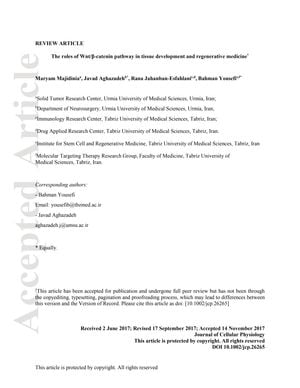The Roles of Wnt/β-Catenin Pathway in Tissue Development and Regenerative Medicine
November 2017
in “
Journal of Cellular Physiology
”

TLDR The Wnt/β-catenin pathway is important for tissue development and has potential in regenerative medicine, but requires more research for therapeutic use.
The 2018 review article outlined the significant role of the Wnt/β-catenin signaling pathway in tissue development and regenerative medicine. It emphasized the pathway's involvement in regulating cell fate, proliferation, and maintenance of stem and cancer stem cells, as well as its contribution to the development and regeneration of various tissues such as the heart, lung, liver, bone, cartilage, kidney, skeletal muscle, and hair follicles. The document highlighted the pathway's dual effects, such as promoting cell proliferation at low signaling levels and suppressing it at high levels, and its varying impact on different tissues, including both positive and negative effects on cardiac repair, lung epithelial cell injury, and kidney repair. The review also discussed the therapeutic potential of modulating the Wnt/β-catenin pathway, including the use of small molecule inhibitors for treating diseases like cancer and fibrosis, and the importance of macrophages in kidney regeneration. It concluded that while the Wnt/β-catenin pathway is crucial for regenerative medicine, more research is needed to optimize its targeting for effective therapies.





